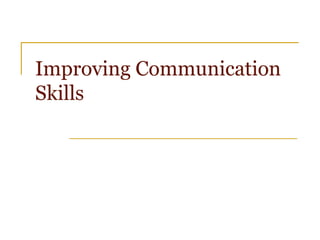
Improve Communication Skills
- 2. A Thought A man is seldom better than his conversation - German Proverb
- 3. Communication Skills Overview Effective communication skills are a critical element in your career and personal lives. We all must use a variety of communication techniques to both understand and be understood.
- 4. What is Communication? Communication is the process of sending and receiving information among people… Feedback receiver sender Medium Encode Decode SENDER RECEIVER
- 5. Most common ways to communicate es lImag V isua ing Speak Bod y La n Writing gua ge
- 6. Communication Goals To change behavior To get and give To get action Information To persuade To ensure understanding
- 8. We need to improve communication... as 70 % of our communication efforts are: misunderstood misinterpreted rejected distorted or not heard 6 people talking in a 2 people conversation!!
- 9. Critical success factor The majority of your perceived ability comes from how you communicate 55% Tonal 38% Visual 7% Verbal 93% of all Communication is non verbal - SKILL
- 10. Listening and Speaking are used a lot… 50% 45% 45% 40% 35% 30% 30% 25% 20% 16% 15% 9% 10% 5% 0% Writing Reading Speaking Listening
- 11. … But not taught enough 50% 45% 45% 40% Am 35% ou nt 30% tau 30% gh 25% t 20% 16% 15% 9% 10% 5% 0% Writing Reading Speaking Listening
- 12. Common Communication Errors: Finishing others’ sentences Preparing our response before someone has completed speaking Multitasking while ‘listening’ Filtering content or meaning based on the speaker Speaking for others (we…)
- 13. A Good Algorithm Communication is a two way process! In order to have good communication: Listen to Understand Understand before speaking Speak to be understood Seek understanding before proceeding Repeat
- 14. How can it be improved Recognition Pavlov study Not being judgmental Stop egocentric communication
- 15. What today’s workshop can achieve Provide ‘knowledge’ about communication Give insight on ‘skills’ needed Suggest ways of going about it What you need to do: Learn the tools Take up every opportunity Practice, Practice, Practice!
- 16. Observe PARIS IN THE THE SPRING GOD IS NOWHERE
- 17. Why is communication important Inspires confidence Builds respect in business and social life Helps make friends Develops a distinct personality Reveals your ability to others
- 18. Essentials of good communication Knowledge Spontaneity in conversation Level of conversation Organising your thoughts Participating in discussions Body Language Show v Tell Being a good listener Listening v hearing
- 19. How to be an active listener Set the stage Ensure mutual understanding Understand body language Suspend judgment Behaviors that hinder effective listening Act distracted (look at your watch!) Tell your own story without acknowledging theirs Give no response Invalidate response, be negative Interrupt Criticize
- 20. Techniques to improve listening skills SUMMARIZE SUMMARIZE PARAPHRASE PARAPHRASE Pull together Pull together Restate what was Restate what was the main points said in your own the main points said in your own of a speaker of a speaker words words QUESTION QUESTION Challenge speaker Challenge speaker to think further, to think further, clarifying both your clarifying both your and their and their understanding understanding
- 21. Two basic types of questions 1. Closed questions: Get a one-word response and inhibit thought. Questions begin with who, when and which 2. Open-ended questions: Invite unique thought, reflection or an explanation. Questions begin with how, what and how come (not why!).
- 22. Practice Questioning Rephrase the following closed questions to make them open-ended: 1. Are you feeling tired? 2. Isn’t it a nice day? 3. Was the last activity useful? 4. Is there anything bothering you? 5. So everything is fine, then?
- 23. Adding colour to communication Images – Describe, relive Show, don’t tell Use audience’s senses Sight Sound Touch Taste Smell
- 24. Improving communication Don’t use cliches Brevity Sincerity Don’t praise yourself Avoid argument Be tactful Silence Enunciation Clear, loud, syllables. Flexibility of tone
- 25. Practice For distinct enunciation, every word, every syllable, every sound, must be given it proper form and value. Think of the mouth chamber as a mold, in which the correct form is given to every sound. Will you please move your lips more noticeably? The teeth should never be kept closed in speech. Through practices, we can learn to speak more rapidly, but still with perfect distinctness
- 26. Ways to gain effective conversation Good use of English – avoid errors Improved vocabulary – overlook v oversee Avoid old phrases Use humour Add interesting story Improve clarity of voice – practice
- 27. Public Speaking
- 28. What does the graphic tell you about this speaker
- 29. The 5-P‘s Prior Preparation Prevents Poor Performance
- 30. From effective conversation to speech Overcoming Fear #1 fear Idea of speech Know your subject Know the audience Target their interest Organising the speech Tell them…
- 31. Developing Your Presentation What is your goal? Research your topic Develop an outline Create or locate learning aids
- 32. AIDA POWERFUL opener ttention CLEAR connector nterest MAIN BODY esire POWERFUL close ction
- 33. AIDA Establish credentials ttention (Me, You, What) Key point Create +ve expectations nterest Paint the future benefits WIFM The facts The facts esire 3 advantages benefits Me, You, What ction is required
- 34. Developing Your Presentation Making the Presentation Interesting Informative Fun Variety Energy Audience Interaction
- 35. Practicing Your Presentation Simulate the presentation setting Practice aloud Practice standing up Time your presentation Memorize your opening few sentences Watch yourself in a mirror
- 36. Presenting Stage fright Feelings follow action Talk ‘to’, not ‘at’ Eye contact Don’t judge your audience Pause Volume Pace
- 37. Summary He who fails to prepare, prepares to fail!
